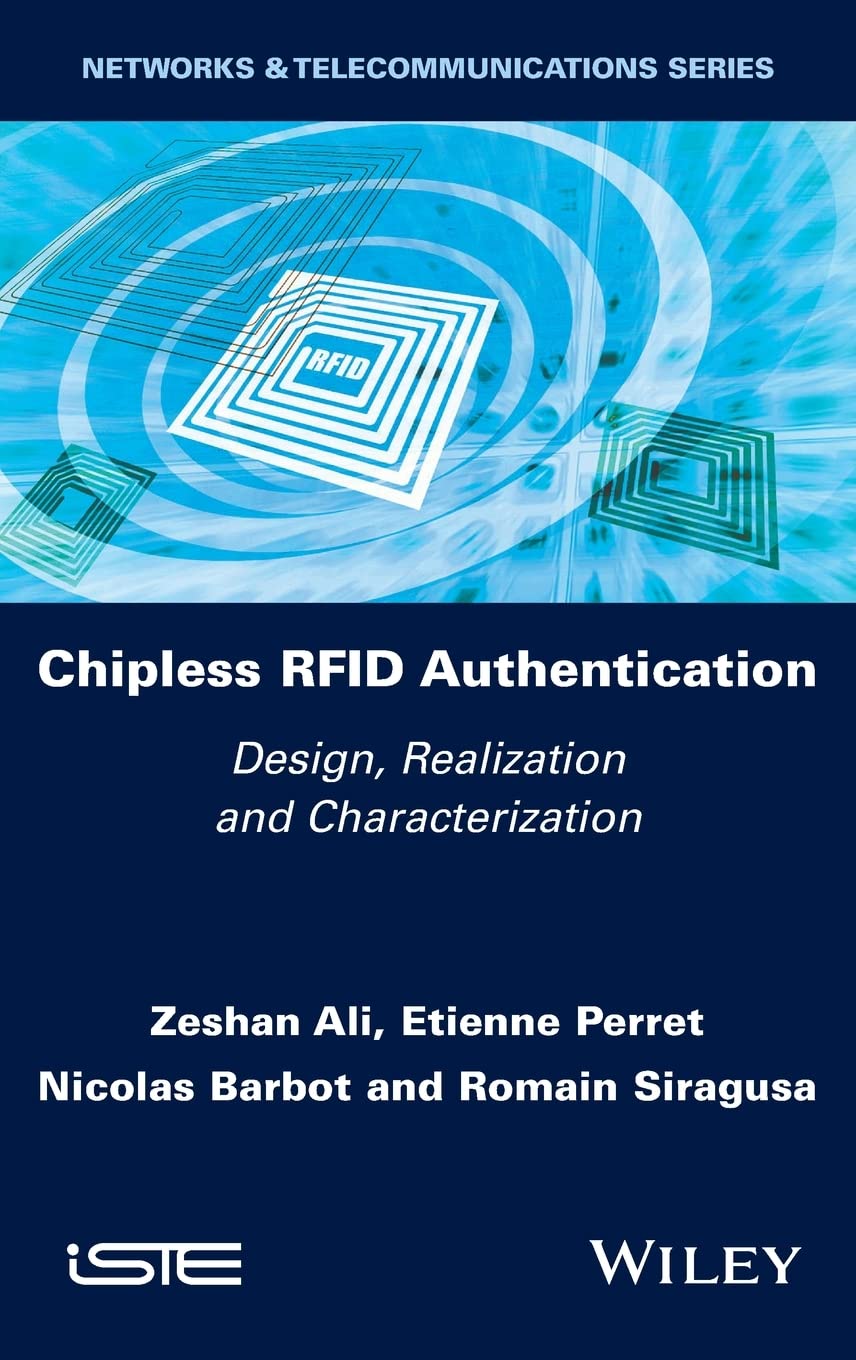| Book Name: | Chipless RFID Authentication |
| Category: | Telecommunication Books |
| Free Download: | Available |
Free PDF Download Chipless RFID Authentication Book

Book Description:
Chipless RFID Authentication examines the development of highly secure product authentication systems for manufactured products by using chipless radio frequency identification (RFID) technology.
The absence of a chip and its compatibility with mass production make chipless RFID an alternative to barcodes. This book discusses how, by using natural randomness inherent to the fabrication process, each chipless RFID tag has a unique signature that can never be reproduced, even if someone tries to copy the label.
The book first explores the state-of-the-art of existing authentication and anti-counterfeiting methods based on their security level. Next, a methodology describing the characterization of chipless RFID tags for the authentication application is presented, followed by a discussion of the extraction of aspect-independent parameters for chipless RFID tags. After proposing designs for the tags, the book presents the realization and characterization of the labels (which exhibit naturally occurring randomness) for authentication using printed circuit boards and inkjet printing on polyethylene terephthalate.
Preface
Counterfeiting has become a global and dynamic phenomenon, as in 2013, the total international trade of counterfeited items was up to 2.5% of the global trade. This illicit practice poses a threat to a wide range of industries and harms societies from various perspectives: ultraexpensive consumer goods (e.g., cosmetics, fragrances, leather articles, jewelry), business-to-business goods (e.g., tools, appliances, materials, replacement parts) and essential consumer goods (e.g., food items, medicines). Product authentication offers vast opportunities to combat fakes in the global supply chain. Therefore, robust and reliable authentication methods have become a global demand to limit counterfeiting.
This book is focused on taking the next step to develop chipless tags for highly secure product authentication applications. Conventional chipless radio frequency identification (RFID) is extended to authentication. Each title has to present a unique signature that can never be reproduced, even if someone tries to copy the tag. For this purpose, natural randomness (i.e., inherent in the fabrication process) along the dimensional parameters of resonators is used. Such genuine randomness can produce unique electromagnetic (EM) signatures that can be used for authentication. First, a methodology to characterize the chipless RFID tag for authentication applications is presented. This methodology consists of procedures to conduct both authentication and statistical analyses. The capabilities of chipless technology to be used for tag discrimination are demonstrated by purposely applying the dimensional variations using two technologies: printed circuit board (PCB) and inkjet printing. Then, the extraction of aspect-independent parameters for chipless RFID tags is presented. For authentication purposes, aspect-independent parameters are directly associated with the physical dimensions of the scatterer of a chipless tag but not associated with the measurement procedure. The random variation of the physical dimensions of the scatterers is then related to aspect-independent parameters, which is particularly promising for chipless authentication.
On the other hand, with the operation of a single measurement, the proposed extraction of aspect-independent parameters is very promising for implementing chipless RFID technology. Finally, chipless authentication methods are presented using naturally occurring randomness in the realization process of PCB chipless tags and inkjet-printed polyethylene terephthalate (PET) chipless tags. The optimization of chipless RFID tags for each realization technology (PCB and inkjet printing) is presented. This optimization is performed to exploit the natural process variations effectively for authentication, unlike the conventional chipless RFID tags that cannot use the variations effectively. To prove this concept, sufficiently large populations of chipless RFID tags are taken. For PCB, chipless RFID tags are realized intermittently twice, each consisting of 45 tags. The two different realizations share the same company, PCB technology, but a different film mask to ensure natural dimensional randomness. Similarity analyses are conducted within each realization and between two intermittent realizations. Finally, the technique is generalized to decrease the probability of error significantly. For inkjet-printed PET tags, an evolution of the possibility of error is presented compared to the optimization of the design of chipless tags. The performance of the system is analyzed by a highly accurate vector network analyzer (VNA)-based reader and a low-cost impulse radio (IR) ultra-wideband (UWB) chipless reader. The probability of error achieved is comparable to the various fingerprint evaluation campaigns found in the literature.
Chipless RFID Authentication: Design, Realization and Characterization PDF
Author(s): Zeshan Ali, Etienne Perret, Nicolas Barbot, Romain Siragusa
Series: Networks & Telecommunications Series
Publisher: Wiley-ISTE, Year: 2022
ISBN: 1786308339,9781786308337









![[PDF] Draw Buildings and Cities in 15 Minutes Draw Buildings and Cities in 15 Minutes pdf](https://www.freepdfbook.com/wp-content/uploads/2021/06/Draw-Buildings-and-Cities-in-15-Minutes-218x150.jpg)








![[PDF] Digital Image Processing An Algorithmic Introduction Using Java Digital Image Processing An Algorithmic Introduction Using Java](https://www.freepdfbook.com/wp-content/uploads/2022/06/Digital-Image-Processing-An-Algorithmic-Introduction-Using-Java.jpg)




![[PDF] 43 Years JEE ADVANCED + JEE MAIN Chapterwise & Topicwise Solved Papers 43 Years JEE ADVANCED (1978-2020) + JEE MAIN Chapterwise & Topicwise Solved Papers Physics PDF](https://www.freepdfbook.com/wp-content/uploads/2022/03/43-Years-JEE-ADVANCED-1978-2020.jpg)

![[PDF] Problems in Physical Chemistry for JEE (Main & Advanced) Problems in Physical Chemistry for JEE (Main & Advanced) Free PDF Book Download](https://www.freepdfbook.com/wp-content/uploads/2022/03/Problems-in-Physical-Chemistry-for-JEE-Main-Advanced.jpg)
![[PDF] Engineering Physics (McGraw Hill)](https://www.freepdfbook.com/wp-content/uploads/2021/05/bafc8c2685bb6823a9c56134f7fba5df.jpeg)

![[PDF] Engineering Chemistry By Shashi Chawla](https://www.freepdfbook.com/wp-content/uploads/2022/05/Theory-And-Practicals-of-Engineering-Chemistry-By-Shashi-Chawla-free-pdf-book.jpeg)
![[PDF] Chemistry: An Introduction to Organic, Inorganic & Physical Chemistry Chemistry: An Introduction to Organic, Inorganic & Physical Chemistry](https://www.freepdfbook.com/wp-content/uploads/2022/04/Chemistry-An-Introduction-to-Organic-Inorganic-Physical-Chemistry.jpg)
![[PDF] Essentials of Physical Chemistry Essentials of Physical Chemistry Free PDF Book by Bahl](https://www.freepdfbook.com/wp-content/uploads/2022/04/Essentials-of-Physical-Chemistry-bahl.jpg)
![[PDF] Biological control of plant-parasitic nematodes: soil ecosystem management in sustainable agriculture Biological control of plant-parasitic nematodes: soil ecosystem management in sustainable agriculture](https://www.freepdfbook.com/wp-content/uploads/2022/05/Biological-control-of-plant-parasitic-nematodes-soil-ecosystem-management-in-sustainable-agriculture.jpg)
![[PDF] Human Anatomy: Color Atlas and Textbook Human Anatomy: Color Atlas and Textbook Free PDF Book](https://www.freepdfbook.com/wp-content/uploads/2022/05/Human-Anatomy-Color-Atlas-and-Textbook.jpg)
![[PDF] Concepts of Biology Book [Free Download]](https://www.freepdfbook.com/wp-content/uploads/2022/05/Concepts-of-Biology.jpg)
![[PDF] Essentials of Biology [Free Download] Essentials of Biology Free PDF BOok Download](https://www.freepdfbook.com/wp-content/uploads/2022/05/Essentials-of-Biology-Free-PDF-Book-Downlaod.jpg)
![[PDF] Human Biology Book [Free Download]](https://www.freepdfbook.com/wp-content/uploads/2022/05/PDF-Human-Biology-Book-Free-Download.jpg)


